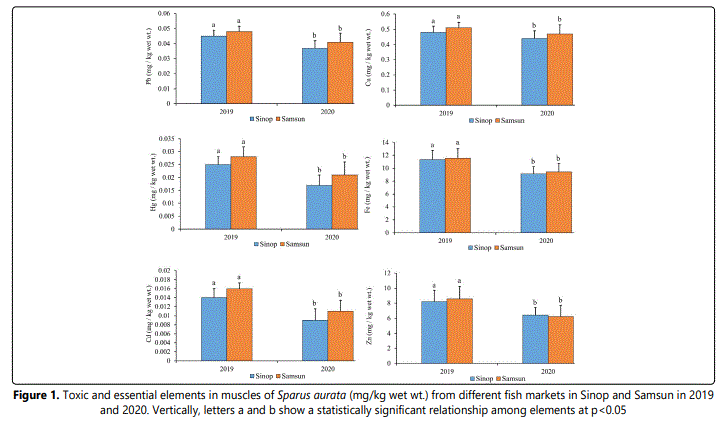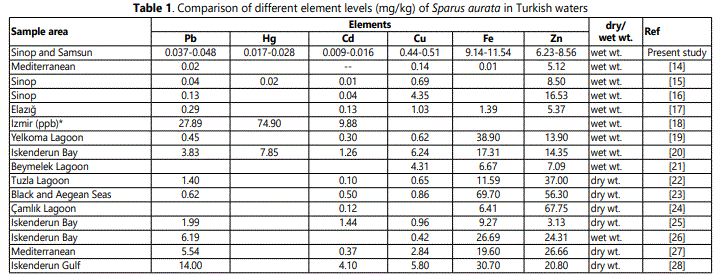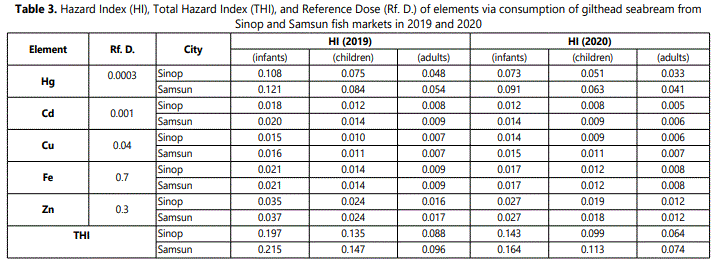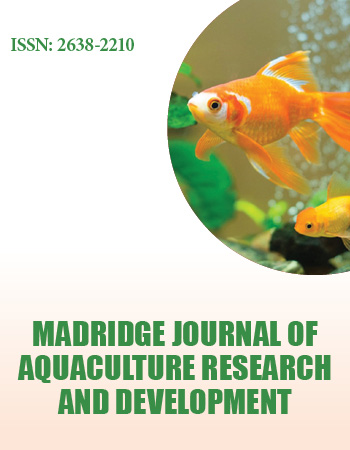Research Article
Assessment of Toxic and Essential Elements in Muscles of Sparus aurata with special Reference to Impacts on Human Health
1Department of Hydrobiology, Fisheries Faculty, University of Sinop, Turkey
2Vocational School of Health Services, University of Sinop, Turkey
3National Oceanographic and Maritime Institute, Dhaka, Bangladesh
4Institute of Marine Science, Faculty of Marine Sciences and Fisheries, University of Chittagong, Chittagong, Bangladesh
*Corresponding author: Levent Bat, Professor, Department of Hydrobiology, Fisheries Faculty, University of Sinop, Akliman Sinop, Turkey, E-mail: leventbat@gmail.com
Received: June 03, 2022 Accepted: June 20, 2022 Published: June 28, 2022
Citation: Bat L, Arici E, Bhuyan MS, Öztekin A, Şahin F. Assessment of Toxic and Essential Elements in Muscles of Sparus aurata with special Reference to Impacts on Human Health. Madridge J Aquac Res Dev. 2022; 3(1): 43-48. doi: 10.18689/mjard-1000109
Copyright: © 2022 The Author(s). This work is licensed under a Creative Commons Attribution 4.0 International License, which permits unrestricted use, distribution, and reproduction in any medium, provided the original work is properly cited.
Abstract
The goal of this investigation was to determine the contamination of toxic (Pb, Hg, Cd) and essential (Cu, Fe, and Zn) elements in the comestible flesh of economically substantial fish gilthead seabream (Sparus aurata) and to assess the dangers of seafood consumption to human health. Fish samples for metal analysis were collected from different fish markets in Sinop and Samsun, respectively. Inductively Coupled Plasma Mass Spectrometry (ICP-MS) was used to examine for toxic and important components in gilthead seabream muscles. The values of Pb, Hg, Cd, Cu, Fe and Zn in S. aurata were found to be between 0.037-0.048, 0.017-0.028, 0.009-0.016, 0.44-0.51, 9.14-11.54 and 6.23-8.56mg/kg wet wt., respectively. The results of this investigation demonstrated that metal concentrations in tissues were under the maximum allowable limit set by the European Commission and the Turkish Food Codex. The measured values were compared to international and national food and human health standards in this study. The estimated daily intake (EDI) amounts for per diem mean consumption and hazard index (HI) in gilthead seabream samples were found to be below human safety levels. To evaluate their standing in zonal surroundings, comparison research was conducted among the accessible current data on elements in S. aurata from different parts of the Turkish seas and those of the current study. Increased levels of heavy metals in fish in various locations could be attributable to an increase in farm inflow water, domestic sewage, and a variety of other anthropogenic sources, all of which should be investigated further. To protect this fish from metal contamination and to decrease the risk to human health, necessary precautions should be taken.
Keywords: Toxic metals, Essential elements, ICP-MS, Sparus aurata, Human health risk
Introduction
One of the most serious environmental issues of the century has been the contamination of the marine environment with chemical contaminants, in particular toxic elements. Consequently, many marine ecosystems are space or time worrying, because of the transfer of elements from different industries into the environment. Non-essential elements are not biologically degradable and persistas toxic over a long time. Essential elements are decomposable and swiftly break down into non-harmful or less harmful forms. Even essential elements can be harmful to oneʼs health if consumed in large enough quantities. Concerns are growing around the world that such toxins are being utilized carelessly, putting marine creatures at danger of contamination and poisoning. Therefore, environmental damage, as well as the presence of contaminants, may impact livelihood and human health.
Many in situ metal accumulation experiments in fish living in contaminated environments have shown that significant levels of different metals can be accumulated in fish tissues without inducing mortality. In advanced species, toxic elements accumulate through the bio-amplifying process in the food web. As a result, they can enter the human body and developing chronic toxicity in body cells. The known cause of cancer is chronic assimilation of components. A framework for developing marine plans for achieving Good Ecological Status (GES) in the ocean ecosystem is set by the Marine Strategy Framework Directive (MSFD) using eleven qualitative descriptors. According to MSFD, the concentration and effects of pollutants including trace elements in the ocean ecosystem should be evaluated because of the effects and threats on the ecosystem.
European Food Safety Authority (EFSA) pointed out that fish is a nutritious food because of the great biological grade proteins, suitable lipid profile, important mineral contents, and vitamins it contains. Its lipid fraction, which is high in omega-3 polyunsaturated fatty acids (PUFA), particularly docosahexaenoic acid (DHA) and eicosapentaenoic acid (EPA), and low in cholesterol, making it a major component of human meals[1]. As a result, determining elements amounts in trading fish is critical to appraise the likely harm of fish consumption to human health[2]. EFSA has stated that the consumption of approximately one-two portions of fish weekly, and up to three-four portions of fish weekly for the time of pregnancy was linked to higher neurodevelopment results among children compared to not consumed[1]. These quantities are likewise related to cause to fall possibility of coronary heart trouble in grown-up persons and comparable with existing intakes and guidelines in nearly all the European countries. At greater intakes, there could be no extra advantage to neuro-developmental outcomes and no reduction to the risk of dying of coronary heart disease [1,3].
Turkeyʼs total fish catch has been reported as 836524 t in 2019, where 463 168 t of this total production came from fishing (431572t of marine and 31596 t of freshwater fish) and 373356 t from aquaculture [4].However, the fish production in 2020 is 785 811 tons, of which 364 400 t were provided by fishing (331 281 t of marine and 33119 t of freshwater fish) and 421 411 t by aquaculture[5]. Although the amounts of fish caught in Turkish waters have been decreasing in recent years, the amount of aquaculture is increasing. While the amount of fish farming in the seas of Turkey was 256 930 tons in 2019, it increased to 293 175 tons in 2020. Likewise, inland fish farming increased from 116 426 tons in 2019 to 128 236 tons in 2020[4,5]. The productions of Gilthead seabream in 2019 and 2020 are99 730 t and 109 749 t, respectively[5]. Gilthead seabream survives in sandy, muddy, and muddy environments with seagrass, which are generally distributed in tropical, subtropical, and temperate zones. Although they are found in all Turkish seas, they are rare in the Black Sea. Their tolerance to salinity is very high. It is among the most valuable species in terms of aquaculture and fishing. It is one of the two most cultivated fish in the Mediterranean basin. The success in aquaculture has been possible by the fact that the species can be obtained alive in large numbers at the entrance and exit of the fish and brackish waters. This species is a carnivorous form and especially adult individuals feed on species belonging to Crustacea and Mollusca families[6].
More information is needed on the levels of contaminants in Turkish fish. Especially commercial fish is a valuable source of protein, which necessitates thorough research and regulation of their contamination levels. This study offers information on muscle tissue elements concentrations of S. aurata regularly consumed on Turkish Black Sea coasts and compares the results to allowed values both at international and national levels and those reported from past studies. These elements are studied well due to the accumulative nature of the fish species and, if consumed enough, are known to produce detrimental health effects. To establish the substantial health hazards associated with the ingestion of contaminated fish, we determined estimated daily index (EDI) amounts for per diem mean consumption and hazard index (HI) in fish samples for infants, children, and adults.
Materials and Methods
A total of 32 random gilthead seabream were obtained from different markets in the provinces of Sinop and Samsun, the crucial fishing cities of the Southern Black Sea Region to assess poisonous (Pb, Hg, Cd) and vital elements (Cu, Fe, and Zn) levels in 2019 and 2020. The length and weight of fish averaged between 25±4 cm and 320±40 g, respectively. The fish were subsequently transported in an icebox to the Hydrobiology laboratory. Fish was kept at a temperature of around 4°C in the laboratory. Bernhardʼs[7] technique was used to prepare the fishʼs muscle for investigation. Individual fish fillets were prepared separately stored at -21°C in a freezer until metal analysis. Aqueous solutions were stored in plastic bottles. They were made acidic (pH: 1-2) to minimize chemisorption and hydrolysis of metal ions.
Following pressure digestion by a certified environmental food analysis laboratory, toxic and essential components in gilthead seabream muscles were analysed using Inductively Coupled Plasma Mass Spectrometry (ICP-MS, Agilent 7700X). Trace elements were determined using acid, wet digestion, and standard reference material according to the European Standard method EN 15763. Samples were weighed and 10 mlin cells of the microwave digestion system approximately 0.5 g by two parallels and 10 ml 65% (v/v) nitric acid was added on the samples. All glass vessels were washed, rinsed, and then soaked in 10-20% (v/v) nitric acid for 24 hours. Plastic vessels were soaked in 1-5 % (v/v) nitric acid. Finally, before using all vessels were rinsed in high purity deionized water. The accuracy of metals in the Certified Reference Materials (CRMs) did not exceed 10%. All values are in milligrams per kilogram of wet weight.
Health assessment of elements in farmed gilthead seabream
A hazardous index (HI) may be used to quantify the risk from metals consumption through the intake as the proportion of the projected element dose (EDI mg/kg/day of body wt.) and the dosage reference (Rf. D. mg/kg/day). The HI was determined using the following formula.
HI = EDI/ Rf. D.
In HI > 1.0, a certain componentʼs EDI is greater than Rf. D., which indicates that this element has a possible risk. The EDI is based on the level of element and the quantity of aqua-cultured S. aurata consumed. The metals EDI were calculated with the following equation:
EDI = Ce ×W / body wt.
Where: Ce is the level of elements in S. aurata; W denotes the per diem average consumption of S. aurata. Annual fish consumption is 5, 10, and 15 kg for infants, children, and adults, respectively [8] and it has been calculated as13, 27, and 41 g/day for infants, children, and adults, respectively; body wt. is the body weight of 10 kg for infants, 30 kg for children and 70 kg for adults.
For Pb and its compounds, Rf. D. values are not given in the current Regional Screening Level (RSL) Summary Table[9]. However, in recent years, oral slope factor (SF) has been used instead of Rf. D. for Pb. SF, on the other hand, is only indicated for Pb and itsʼcontents as 0.0085 mg/kg-day[10]. The following formula was used to compute the risk index (RI):
RI= EDI x SF
The RI is taken into account as insignificant if the RI<10-6, permissible or acceptable if RI is 10-6<RI<10-4, and likewise regarded substantial if the RI > 10-4.
As seen in the following equation, the Total Hazard Index (THI) is the sum of the HIs:
THI= HI (Pb) + HI (Hg) + HI (Cd) + HI (Cu) + HI (Fe) + HI (Zn)
Results and Discussion
The concentrations (Mean ± S.D) of toxic and vital metals in the muscles of S. aurata are given in Figure 1. The values of Pb, Hg, Cd, Cu, Fe and Zn in S. aurata from different fish markets in Sinop and Samsun in 2019 and 2020 were found to be between 0.037-0.048, 0.017-0.028, 0.009-0.016, 0.44-0.51, 9.14-11.54 and 6.23-8.56 mg/kg wet wt., respectively. All metal levels were found in muscle samples, according to the findings of this investigation. Among studied elements, Fe had the highest mean concentration in gilthead seabream muscles collected from fish markets in Sinop and Samsun, followed by Zn and Cu. These essential elements are critical trace nutrients required by fish at little levels. These metalsʼ impacts on marine animals can be lethal, either directly or indirectly. Cd, Hg, and Pb are non-essential heavy metals that have no biological function in life forms and are toxic in even small amounts. These non-biodegradable, non-essential elements are extremely dangerous pollutants, and their absorption and biomagnification in aquatic ecosystems are seriously toxic, especially above safe levels, can have major ramifications for the food chain and, eventually, people. Cd, Hg, and Pb contents were found below the permissible limits of European Union Commission Regulation and Turkish Food Codex i.e., 0.05, 0.5, and 0.3 mg/kg wet wt., respectively [11,12].

Essential elements were found to be higher than nonessential toxic elements levels. To assess the risk of element levels for consumers, the fish edible tissues were analysed. Although there is no maximum allowable level for Fe, the acceptable levels for Cu and Zn are 20 and 50 mg/kg wet wt.[13]. These values are well below the values we obtained from our current study (Table 1). As a result of the comparison between the mean element concentrations determined in muscle and international recommended limits, none of the fish samples had exceeded the limits for the examined elements. Muscles are not an active site for element bioaccumulation, implying that the element concentrations in S. aurata may be regarded benign and acceptable for people. The study reveals that S. aurata produced through fish farming practices, being contaminated with elements are safe to consume.
There was no statistical difference between the metal levels detected in S. aurata purchased from the markets in the cities of Sinop and Samsun (p>0.05). Though the metal amounts in the fish taken in 2019 were found to be higher than those taken in 2020, and there is a statistical difference (p<0.05).This may be because, after March 2020, many industrial activities were reduced, human activities were greatly restricted, and much fewer contaminants entered the surrounding water where the culture cages are located due to the Coronavirus Disease (COVID-19).Elements levels in gilthead seabream tissue vary significantly between investigations, according to the research (Table 1). Fe and Zn were found at the highest values, followed by the essential element Cu. As expected in general, toxic Cd, Hg, and Pb were found to be lower. In comparison made by considering wet and dry weights (Table 1), Pb [26], Hg [20], Cd [25], Cu [20] and Zn [26] levels were found to be highest in Iskendurun Bay, whereas the highest Fe [22] level was found in Yeloma Lagoon. Higher levels of heavy metals in fish in different places could be due to an increase in farm inflow water, residential sewage, and several anthropogenic sources, all of which should be looked into more. The findings of this research reveal that the build-up of components harms gilthead seabream sold in Sinop, and Samsun is quite low. The results of the present study compared with other study carried out by various scientists (Table 1).

Health risk assessment due to consumption of Sparus aurata
Estimated Daily Intake (EDI): The daily intakes (EDI) of the non-essential and essential elements were estimated considering the average of the element in S. aurata and the average intake of fish per day for infants, children, and adults respectively as reported by UNSCEAR [8]. EDIʼs of toxic elements (Pb, Hg, Cd) and essential elements (Cu, Fe, Zn) via consumption of gilthead seabream from Sinop and Samsun fish markets in 2019 and 2020 are shown in Table 2.

The daily consumption of Pb, Hg, Cd, Cu, Fe and Zn in gilthead seabream from Sinop and Samsun fish markets in 2019 and 2020 ranged from 2.16E-05 to 6.24E-05, 9.95E-06 to 3.64E-05, 5.27E-06 to 2.08E-05, 2.57E-04 to 6.63E-04, 5.35E03 to 1.50E-02 and 3.65E-03 to 1.11E-02 µg/day/person, respectively. The average daily intakeof elements through gilthead seabream consumption can be ordered as follows: Fe>Zn>Cu>Pb>Hg>Cd. These values are considerably lower than the recommended values of Commission Regulation [11] and Turkish Food Codex [12].
Hazard Index (HI): The HI, which is a ratio of the estimated exposure to the oral reference dose, is used to estimates the potential non-carcinogenic risk of the consumers of the discerned contaminated seafood like fish. The estimated HIs of the elements reveals that the elements in the muscles of Sparus aurata do not appear to represent any hazard to the people, as seen in Table 3, where the THIs of all the investigated elements are less than one.
Except for Pb, which was not given a reference dose, the THI of all other elements was well below 1 (Table 3). Therefore, it can be said that the consumption of gilthead seabream from Sinop and Samsun fish markets does not pose any health risk when it comes to the toxic and essential elements examined.

Risk Index (RI): Similarly, since the RI for Pb was less than 10-6 in both 2019 and 2020 from the cities of Sinop and Samsun, it was calculated as permissible or acceptable for infants, children, and adults (Table 4), and the risk index was considered insignificant. The findings indicated that all metals are within permitted limits, and customers are free to utilize them. Thus, gilthead seabream is regarded to have a high level of food safety. This assumes that the person obtains all their fish stores from the Sinop and Samsun fish markets and that food processing has no effects on the levels of toxic and essential elements present in the muscles of gilthead seabream.

Conclusion
The presence of toxic (Pb, Hg, Cd) and essential (Cu, Fe, and Zn) elements was determined in the edible tissues of economically important fish gilthead seabream, however, in quantities even below the allowable limits set by the European Union Commission Regulation [11] and Turkish Food Codex [12,13]. Being aware of the element levels in farmed fish is critical for the regionʼs environmental health, aquatic lifeʼs well-being, and human fish consumption. The findings of the current S. aurata concentration testing showed that both toxic and essential elements levels were below the required requirements. It should be noted that the intake of these gilthead seabreams from the researched area as foods during the time of the study may not pose health risks for people. Gilthead seabream is popular seafood in many countries across the world, and itʼs a crucial technique for determining the impacts of multiple pollutants on marine ecosystems. In addition, the results from this study would contribute to the consolidation of the limited baseline data for evaluating the distribution of elements in S. aurata. Using these data, it can now be confirmed that S. aurata, which is very abundant in Turkish waters, is considered safe for consumption. In Turkey, all seafood, including fish, is inspected for food safety before being consumed by humans. The findings of this study can be used as a baseline for future safety monitoring of S. aurata and other species cultivated in the area.
Acknowledgements: The authors would like to thank all colleagues for help and support this research and wish to acknowledge the Department of Hydrobiology, Fisheries Faculty, University of Sinop for providing laboratory facilities during the study
References
- EFSA NDA Panel (EFSA panel on dietetic products, nutrition and allergies). Scientific opinion on health benefits of seafood (fish and shellfish) consumption in relation to health risks associated with exposure to methylmercury. EFSA J. 2014; 12(7): 3761. doi: 10.2903/j.efsa.2014.3761
- Bat L. One health: The interface between fish and human health. Current World Environ. 2019; 14(3): 355-57. doi: 10.12944/CWE.14.3.04
- James D. Risks and benefits of seafood consumption. AGRIS. 2013; 108: 28.
- Froese R, Pauly D. Fish Base. World Wide Web electronic publication 2021. Accessed January 4, 2022.
- USEPA (United States Environmental Protection Agency). Regional Screening Levels (RSLs) - Generic Tables. Accessed January, 2022.
- RAIS (The Risk Assessment Information System). University of Tennessee. Accessed December 5, 2021.
- Korkmaz C, Ay Ö, Ersoysal Y, Köroğlu MA, Erdem C. Heavy metal levels in muscle tissues of some fish species caught from northeast Mediterranean: Evaluation of their effects on human health. J Food Comp Analy. 2019; 81: 1-9. doi: 10.1016/j.jfca.2019.04.005
- Bat L, Öztekin A, Arıcı E. Assessment in terms of human health some heavy metals concentrations determined in Dicentrarchus labrax (Linnaeus, 1758) and Sparus aurata (Linnaeus, 1758) marketed in Sinop (Turkey). Alınteri J Agri Sci. 2018; 33(1): 51-54. doi: 10.28955/alinterizbd.358158
- Bat L, Sezgin M, Üstün F, Şahin F. Heavy metal concentrations in ten species of fishes caught in Sinop coastal waters of the Black Sea, Turkey. TrJFAS. 2012; 12: 371-376. doi: 10.4194/1303-2712-v12_2_24
- Ilhak OI, Karatepe P, Özçelik M. Heavy metal levels in some fish species sold at retail in Elazig. Fırat Univ Sag Bil Vet Der. 2012; 26(2): 99-103.
- Yabanlı M, Alparslan Y, Baygar T. Assessment of cadmium, mercury and lead contents of frozen European sea bass (Dicentrarchus labrax L., 1758) and gilthead sea bream (Sparus aurata L., 1758) fillet from Turkey. Agr Sci. 2012; 3(5): 669-73. doi: 10.4236/as.2012.35081
- Türkmen A, Türkmen M, Tepe Y, Çekiç M. Metals in tissues of fish from Yelkoma Lagoon, northeastern Mediterranean. Environ Monit Assess. 2010; 168: 223-30. doi: 10.1007/s10661-009-1106-3
- Dural M, Genç E, Sangun MK, Güner Ö. Accumulation of some heavy metals in Hysterothylacium aduncum (Nematoda) and its host sea bream, Sparus aurata (Sparidae) from North-Eastern Mediterranean Sea (Iskenderun Bay). Environ Monit Assess. 2011; 174: 147–55. doi: 10.1007/s10661-010-1445-0
- Uysal K, Emre Y, Köse E. The determination of heavy metal accumulation ratios in muscle, skin and gills of some migratory fish species by inductively coupled plasma-optical emission spectrometry (ICP-OES) in Beymelek Lagoon (Antalya/Turkey). Microchem J. 2008; 90(1): 67-70. doi: 10.1016/j.microc.2008.03.005
- Dural M, Lugal Göksu MZ, Özak AA. Investigation of heavy metal levels in economically important fish species captured from the Tuzla lagoon. Food Chem. 2007; 102(1): 415-21. doi: 10.1016/j.foodchem.2006.03.001
- Uluozlu ÖD, Tüzen M, Mendil D, Soylak M. Trace metal content in nine species of fish from the Black and Aegean Seas, Turkey. Food Chem. 2007; 104(2): 835-40. doi: 10.1016/j.foodchem.2007.01.003
- Dural M, Lugal Göksu MZ, Özak AA, Derici B. Bioaccumulation of some heavy metals in different tissues of Dicentrarchus labrax L, 1758, Sparus aurata L, 1758 and Mugil cephalus L, 1758 from the Camlik lagoon of the eastern coast of Mediterranean (Turkey). Environ Monit Assess. 2006; 118 (1-3): 65-74. doi: 10.1007/s10661-006-0987-7
- Türkmen A, Türkmen M, Tepe Y, Akyurt I. Heavy metals in three commercially valuable fish species from Iskenderun Bay, Northern East Mediterranean Sea, Turkey. Food Chem. 2005; 91(1): 167-72. doi: 10.1016/j.foodchem.2004.08.008
- Yılmaz AB. Comparison of heavy metal levels of Grey Mullet (Mugil cephalus L.) and Sea Bream (Sparus aurata L.) caught in Iskenderun Bay (Turkey). Turk J Vet Anim Sci. 2005; 29: 257-262.
- Canlı M, Atlı G. The relationships between heavy metal (Cd, Cr, Cu, Fe, Pb, Zn) levels and the size of six Mediterranean fish species. Environ Poll. 2003; 121(1): 129-36. doi: 10.1016/S0269-7491(02)00194-X
- Kargin F. Seasonal changes in levels of heavy metals in tissues of Mullus barbatus and Sparus aurata collected from Iskenderun Gulf (Turkey). Wat Air Soil Poll. 1996; 90: 557-62. doi: 10.1007/BF00282669


